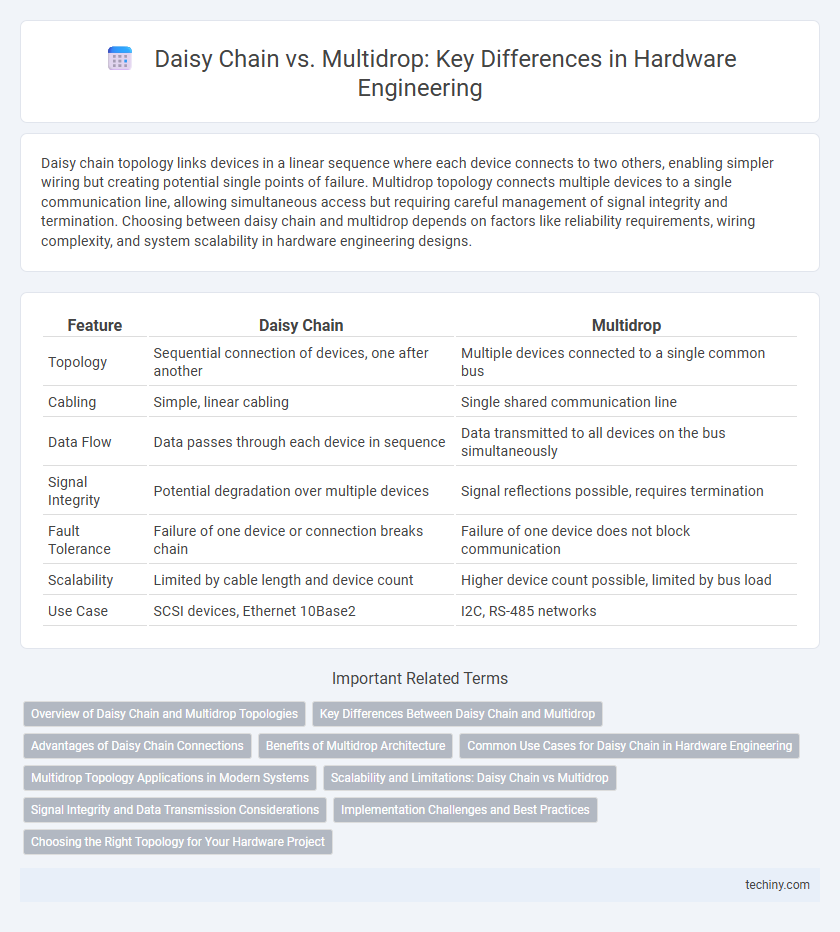Daisy chain topology links devices in a linear sequence where each device connects to two others, enabling simpler wiring but creating potential single points of failure. Multidrop topology connects multiple devices to a single communication line, allowing simultaneous access but requiring careful management of signal integrity and termination. Choosing between daisy chain and multidrop depends on factors like reliability requirements, wiring complexity, and system scalability in hardware engineering designs.
Table of Comparison
| Feature | Daisy Chain | Multidrop |
|---|---|---|
| Topology | Sequential connection of devices, one after another | Multiple devices connected to a single common bus |
| Cabling | Simple, linear cabling | Single shared communication line |
| Data Flow | Data passes through each device in sequence | Data transmitted to all devices on the bus simultaneously |
| Signal Integrity | Potential degradation over multiple devices | Signal reflections possible, requires termination |
| Fault Tolerance | Failure of one device or connection breaks chain | Failure of one device does not block communication |
| Scalability | Limited by cable length and device count | Higher device count possible, limited by bus load |
| Use Case | SCSI devices, Ethernet 10Base2 | I2C, RS-485 networks |
Overview of Daisy Chain and Multidrop Topologies
Daisy chain topology interconnects devices in a linear sequence, where each device is connected to the next, enabling simplified wiring but potentially increased latency and limited fault tolerance. Multidrop topology connects multiple devices to a single communication line or bus, allowing simultaneous access but requiring robust arbitration to prevent data collisions. Both topologies are essential in hardware engineering for optimizing signal routing and device communication based on specific application requirements.
Key Differences Between Daisy Chain and Multidrop
Daisy chain topology connects devices in a linear sequence where each device is linked to exactly two others, except the endpoints, optimizing signal integrity and simplifying cabling in hardware engineering applications. Multidrop topology features multiple devices connected to a single communication line, allowing shared access but potentially leading to signal degradation and increased bus contention. Key differences include the linear vs. shared communication path, impact on signal quality, and complexity of device addressing and fault isolation.
Advantages of Daisy Chain Connections
Daisy chain connections in hardware engineering offer streamlined wiring that reduces cable clutter and simplifies system design, enhancing overall reliability. Each device connects sequentially, allowing easy addition or removal without disrupting the entire network, which minimizes downtime during maintenance. This topology also improves signal integrity by limiting parallel connections, leading to better performance in high-speed data transfer applications.
Benefits of Multidrop Architecture
Multidrop architecture reduces wiring complexity by allowing multiple devices to share a common communication line, lowering costs and simplifying PCB design in hardware engineering. It enhances scalability and flexibility, making it easier to add or remove devices without reconfiguring the entire system. Multidrop improves fault tolerance and maintenance efficiency by isolating failures to individual devices rather than the entire chain.
Common Use Cases for Daisy Chain in Hardware Engineering
Daisy chain configurations are widely used in hardware engineering for connecting multiple devices in series, such as in USB, FireWire, and DisplayPort interfaces, where simplicity and reduced cabling are essential. Common use cases include connecting peripherals like keyboards, mice, and storage devices, enabling easy expansion without complex wiring. This method is ideal for systems requiring sequential data transfer and minimized port usage, enhancing scalability and maintainability in embedded and industrial applications.
Multidrop Topology Applications in Modern Systems
Multidrop topology is widely used in modern systems such as automotive networks, industrial control systems, and memory buses due to its cost-effective wiring and ease of node addition. This topology enables multiple devices to share a common communication line, reducing the complexity and weight of harnesses in embedded systems. Its efficient scalability suits applications requiring moderate data rates and robust fault tolerance without the need for extensive point-to-point connections.
Scalability and Limitations: Daisy Chain vs Multidrop
Daisy chain architectures offer limited scalability due to cumulative latency and potential signal degradation as devices increase in number, restricting efficient expansion in hardware systems. Multidrop topologies provide better scalability with a shared communication line that supports multiple devices but face bandwidth contention and signal integrity challenges as device count grows. Understanding these trade-offs is crucial for hardware engineers when designing systems requiring optimized communication performance and expansion flexibility.
Signal Integrity and Data Transmission Considerations
Daisy chain topology connects devices in series, which can introduce signal degradation and reflections due to impedance mismatches, impacting signal integrity and limiting data transmission speed. Multidrop configurations share a common communication line among multiple devices, increasing capacitive loading and noise susceptibility, potentially causing signal attenuation and timing issues. Careful line termination and controlled impedance design are critical in both approaches to maintain robust signal integrity and reliable high-speed data transfer.
Implementation Challenges and Best Practices
Implementing daisy chain topology in hardware engineering presents challenges such as signal degradation and timing issues due to the sequential connection of devices, requiring careful impedance matching and termination techniques. Multidrop configurations face difficulties with bus loading and reflections, necessitating meticulous cable design and standardized pull-up resistors to maintain signal integrity. Best practices include thorough simulation of signal paths and adherence to industry standards like RS-485 to optimize performance and reliability in both topologies.
Choosing the Right Topology for Your Hardware Project
Selecting the right topology for hardware projects hinges on balancing signal integrity and scalability; daisy chain topology offers simplicity by connecting devices in series but can suffer from increased latency and fault sensitivity. Multidrop topology supports multiple devices on a single bus, improving device count and wiring complexity but may face challenges with signal reflections and termination. Evaluating project requirements such as device count, communication speed, and fault tolerance guides optimal topology selection, ensuring robust and efficient hardware performance.
Daisy chain vs Multidrop Infographic

 techiny.com
techiny.com